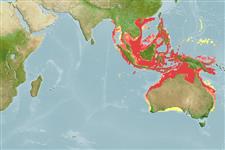Environment: milieu / climate zone / depth range / distribution range
Ecologia
marinhas associadas(os) a recifes; anfídromo (Ref. 51243); intervalo de profundidade 1 - 350 m (Ref. 38189). Subtropical; 45°N - 44°S, 89°E - 154°E
Eastern Indian Ocean, Malay Peninsula, southern Philippines, northern Java, Arafura Sea, Louisiade Archipelago, and northern half and southwestern Australia. Reports of Introduction in the Mediterranean are questionable. Confirmed and questionable reports of its occurrence (and references) are discussed in Inoue & Nakabo 2006 (Ref. 57869:385-6).
Comprimento de primeira maturação / Tamanho / Peso / Idade
Maturity: Lm 19.8 range ? - ? cm
Max length : 50.0 cm SL macho/indeterminado; (Ref. 3397); common length : 30.0 cm TL macho/indeterminado; (Ref. 5450); idade máx. registrada: 7 anos (Ref. 94612)
Espinhos dorsais (total): 0; Raios dorsais (total): 11-12; Espinhos anais 0; Raios anais : 11 - 12. Cigar-shaped, rounded or slightly compressed; the head pointed and depressed; the snout rounded. Dorsal origin closer to the adipose origin than the snout tip. Anal fin origin is closer to the tail base than the operculum. Color is brown-gray above and creamy below, with 8-10 indistinct darker spots along the middle of the sides.
Found on the sublittoral zone above 100 m over sand or mud bottoms of coastal waters (Ref. 11228, 11230). Feeds on fishes (anchovy and red mullet Mullus surmuletus), crustaceans, and other invertebrates (Ref. 5213). Spawns from April to May off Japan. Generally marketed frozen, sometimes fresh and as fish cakes ('kamaboko') in Japan (Ref. 4964). Minimum depth from Ref. 12260.
Russell, B.C., 1999. Synodontidae: lizardfishes (also bombay ducks, sauries). p. 1928-1945. In K.E. Carpenter and V.H. Niem (eds.) FAO species identification guide for fishery purposes. The living marine resources of the Western Central Pacific. Vol. 3. Batoid fishes, chimaeras and bony fishes. Part 1 (Elopidae to Linophrynidae). FAO, Rome. pp. 1397-2068. (Ref. 38189)
Status na Lista Vermelha da UICN (Ref. 130435)
Ameaça para os humanos
Harmless
Uso pelos humanos
Pescarias: pouco comercial
Ferramentas
Relatórios especiais
Baixar XML
Fontes da internet
Estimates based on models
Preferred temperature (Ref.
123201): 18.8 - 27.9, mean 26 °C (based on 583 cells).
Índice de diversidade filogenética (Ref.
82804): PD
50 = 0.5000 [Uniqueness, from 0.5 = low to 2.0 = high].
Bayesian length-weight: a=0.00537 (0.00465 - 0.00621), b=3.10 (3.06 - 3.14), in cm total length, based on LWR estimates for this species (Ref.
93245).
Nível Trófico (Ref.
69278): 4.5 ±0.4 se; based on diet studies.
Generation time: 2.7 (2.1 - 3.7) years. Estimated as median ln(3)/K based on 37
growth studies.
Resiliência (Ref.
120179): médio(a), tempo mínimo de duplicação da população 1,4 - 4,4 anos (K=0.3-0.9; tm=1-2; tmax=8; Fec=84,802).
Fishing Vulnerability (Ref.
59153): Moderate vulnerability (39 of 100).
Climate Vulnerability (Ref.
125649): Low vulnerability (25 of 100).
Nutrients (Ref.
124155): Calcium = 20.3 [6.4, 45.4] mg/100g; Iron = 0.406 [0.138, 0.948] mg/100g; Protein = 16 [14, 19] %; Omega3 = 0.105 [0.035, 0.259] g/100g; Selenium = 22.4 [8.0, 51.5] μg/100g; VitaminA = 63.6 [15.2, 235.3] μg/100g; Zinc = 0.508 [0.287, 0.826] mg/100g (wet weight); based on
nutrient studies.
